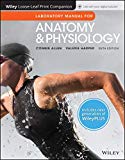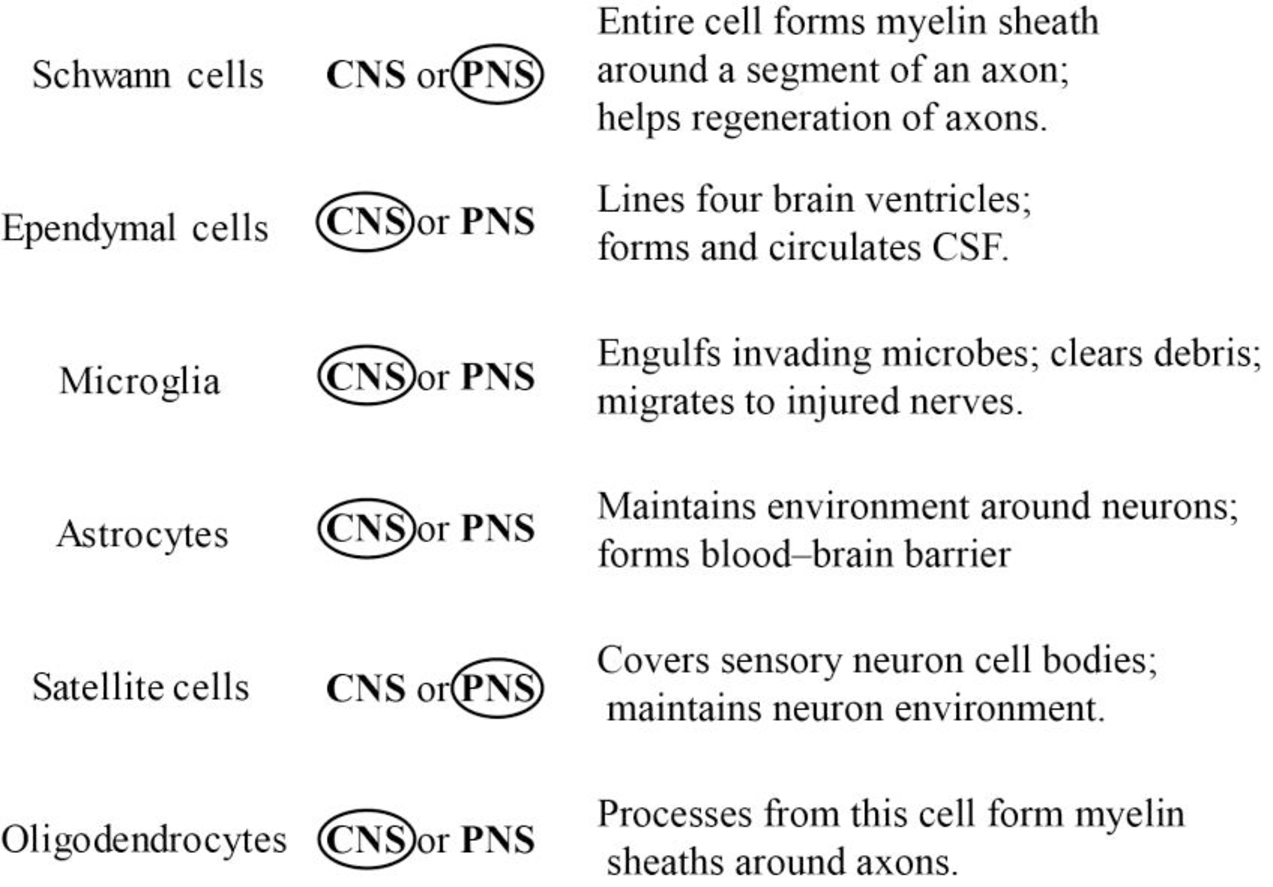
Concept explainers
The nervous system is composed of two components, which includes the central nervous system and the peripheral nervous system. The central nervous system includes the brain and the spinal cord, whereas the peripheral nervous system includes the motor and the sensory receptors. The brain is composed of nerve tissues that are protected within the skull. The major functions of the brain include processing sensory information, releasing hormones, and regulating blood pressure and breathing.
Answer to Problem 1.1BGL

Explanation of Solution
Schwann cell:
The Schwann cell is a glial cell that plays an important role in supporting the PNS. The Schwann cell, also termed as neurilemma cell, is a type of nervous tissue cell in PNS involved in producing the myelin sheath around the neuronal axons and also helps in regenerating the axons.
Ependymal cell:
The ependymal cell is a neuronal support cell, known as neuroglia, which forms the epithelial lining of the ventricles present in the brain and also the central canal of the spinal cord. Moreover, the ependymal cells give rise to the epithelial layer that encircles the choroid plexus. The choroid plexus is a collection of blood vessels that exist in the lateral ventricle walls. Cilia, present in the ventricles of the ependymal cell, help in influencing the cerebrospinal fluid direction and also bring nutrients and other substances to the neuron.
Microglia:
Microglia is a type of neuroglial cell that supports the CNS as it functions as an immune cell. The microglial cell is the smallest cell of all the neuroglia. Its main role is to mediate the immune response in the CNS by acting as macrophage, removing dead neurons, and cellular debris from the nervous tissue through the phagocytosis process.
Astrocytes:
Astrocytes, also termed as astroglia, which is characterized by star-shaped glial cells present in the brain and the spinal cord. It performs numerous functions, like axon guidance, synaptic support, controls blood-brain barrier, and also controls the blood flow. In addition, astrocytes are majorly responsible for homeostasis of the CNS.
Satellite cell:
The satellite cell, also termed as muscle stem cell or myosatellite cell, is a multipotent, flattened cell that usually exists in the ganglia (sympathetic ganglia, parasympathetic ganglia, and sensory ganglia) of the PNS. It encompasses a small amount of cytoplasm present in the mature muscle. The satellite cell plays a major role in regulating and stabilizing the environment around ganglion cell bodies.
Oligodendrocytes:
Oligodendrocyte is a type of neuroglia that supports the CNS by providing support and insulation to axons. The oligodendrocytes create an isolating sheath around the axons for rapid conduction of the signal. This may lead to massive conduction of electrical signals inside the axon.
Want to see more full solutions like this?
Chapter 16 Solutions
Laboratory Manual for Anatomy and Physiology, 6e WileyPLUS (next generation) + Loose-leaf
- Identify the indicated tissue? (stem x.s.) parenchyma collenchyma sclerenchyma ○ xylem ○ phloem none of thesearrow_forwardWhere did this structure originate from? (Salix branch root) epidermis cortex endodermis pericycle vascular cylinderarrow_forwardIdentify the indicated tissue. (Tilia stem x.s.) parenchyma collenchyma sclerenchyma xylem phloem none of thesearrow_forward
- Identify the indicated structure. (Cucurbita stem l.s.) pit lenticel stomate tendril none of thesearrow_forwardIdentify the specific cell? (Zebrina leaf peel) vessel element sieve element companion cell tracheid guard cell subsidiary cell none of thesearrow_forwardWhat type of cells flank the opening on either side? (leaf x.s.) vessel elements sieve elements companion cells tracheids guard cells none of thesearrow_forward
- What specific cell is indicated. (Cucurbita stem I.s.) vessel element sieve element O companion cell tracheid guard cell none of thesearrow_forwardWhat specific cell is indicated? (Aristolochia stem x.s.) vessel element sieve element ○ companion cell O O O O O tracheid O guard cell none of thesearrow_forwardIdentify the tissue. parenchyma collenchyma sclerenchyma ○ xylem O phloem O none of thesearrow_forward
- Please answer q3arrow_forwardRespond to the following in a minimum of 175 words: How might CRISPR-Cas 9 be used in research or, eventually, therapeutically in patients? What are some potential ethical issues associated with using this technology? Do the advantages of using this technology outweigh the disadvantages (or vice versa)? Explain your position.arrow_forwardYou are studying the effect of directional selection on body height in three populations (graphs a, b, and c below). (a) What is the selection differential? Show your calculation. (2 pts) (b) Which population has the highest narrow sense heritability for height? Explain your answer. (2 pts) (c) If you examined the offspring in the next generation in each population, which population would have the highest mean height? Why? (2 pts) (a) Midoffspring height (average height of offspring) Short Short Short Short (c) Short (b) Short Tall Short Tall Short Short Tall Midparent height (average height of Mean of population = 65 inches Mean of breading parents = 70 inches Mean of population = 65 inches Mean of breading parents = 70 inches Mean of population = 65 inches Mean of breading parents = 70 inchesarrow_forward
 Human Anatomy & Physiology (11th Edition)BiologyISBN:9780134580999Author:Elaine N. Marieb, Katja N. HoehnPublisher:PEARSON
Human Anatomy & Physiology (11th Edition)BiologyISBN:9780134580999Author:Elaine N. Marieb, Katja N. HoehnPublisher:PEARSON Biology 2eBiologyISBN:9781947172517Author:Matthew Douglas, Jung Choi, Mary Ann ClarkPublisher:OpenStax
Biology 2eBiologyISBN:9781947172517Author:Matthew Douglas, Jung Choi, Mary Ann ClarkPublisher:OpenStax Anatomy & PhysiologyBiologyISBN:9781259398629Author:McKinley, Michael P., O'loughlin, Valerie Dean, Bidle, Theresa StouterPublisher:Mcgraw Hill Education,
Anatomy & PhysiologyBiologyISBN:9781259398629Author:McKinley, Michael P., O'loughlin, Valerie Dean, Bidle, Theresa StouterPublisher:Mcgraw Hill Education, Molecular Biology of the Cell (Sixth Edition)BiologyISBN:9780815344322Author:Bruce Alberts, Alexander D. Johnson, Julian Lewis, David Morgan, Martin Raff, Keith Roberts, Peter WalterPublisher:W. W. Norton & Company
Molecular Biology of the Cell (Sixth Edition)BiologyISBN:9780815344322Author:Bruce Alberts, Alexander D. Johnson, Julian Lewis, David Morgan, Martin Raff, Keith Roberts, Peter WalterPublisher:W. W. Norton & Company Laboratory Manual For Human Anatomy & PhysiologyBiologyISBN:9781260159363Author:Martin, Terry R., Prentice-craver, CynthiaPublisher:McGraw-Hill Publishing Co.
Laboratory Manual For Human Anatomy & PhysiologyBiologyISBN:9781260159363Author:Martin, Terry R., Prentice-craver, CynthiaPublisher:McGraw-Hill Publishing Co. Inquiry Into Life (16th Edition)BiologyISBN:9781260231700Author:Sylvia S. Mader, Michael WindelspechtPublisher:McGraw Hill Education
Inquiry Into Life (16th Edition)BiologyISBN:9781260231700Author:Sylvia S. Mader, Michael WindelspechtPublisher:McGraw Hill Education





